
Mysida is an order of small, shrimp-like crustaceans in the malacostracan superorder Peracarida. Their common name opossum shrimps stems from the presence of a brood pouch or "marsupium" in females. The fact that the larvae are reared in this pouch and are not free-swimming characterises the order. The mysid's head bears a pair of stalked eyes and two pairs of antennae. The thorax consists of eight segments each bearing branching limbs, the whole concealed beneath a protective carapace and the abdomen has six segments and usually further small limbs.

Isopoda is an order of crustacean, which includes woodlice and their relatives. Members of this group are called Isopods and include both terrestrial and aquatic species. All have rigid, segmented exoskeletons, two pairs of antennae, seven pairs of jointed limbs on the thorax, and five pairs of branching appendages on the abdomen that are used in respiration. Females brood their young in a pouch under their thorax.
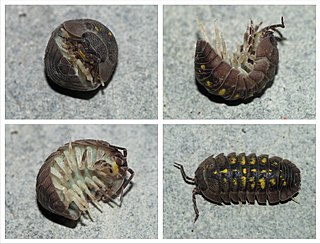
Armadillidium is a genus of the small terrestrial crustacean known as the woodlouse. Armadillidium are also commonly known as pill woodlice, leg pebbles, pill bugs, roly-poly, or potato bugs, and are often confused with pill millipedes such as Glomeris marginata. They are characterised by their ability to roll into a ball ("volvation") when disturbed.
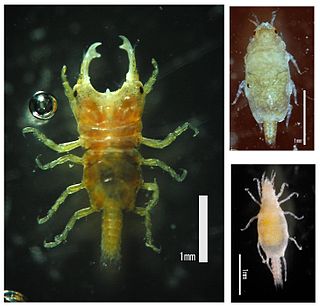
The Gnathiidae are a family of isopod crustaceans. They occur in a wide range of depths, from the littoral zone to the deep sea. The adults are associated with sponges and may not feed. The juvenile form is known as a 'praniza', and it is a temporary parasite of marine fish. These forms are not larvae; Gnathiidae instead become parasitic during the manca stage. Mancae of the Gnathiidae closely resemble the adult form, however they lack the final pair of pereiopods.

A gribble /ˈgɹɪbəl/ is any of about 56 species of marine isopod from the family Limnoriidae. They are mostly pale white and small crustaceans, although Limnoria stephenseni from subantarctic waters can reach 10 mm (0.4 in).
The Old World silversides are a family, Atherinidae, of fish in the order Atheriniformes. Atherinidae are abundant and considered bony fish (teleost) that are widespread globally, living in rivers, estuaries, and coastal waters. They occur worldwide in tropical and temperate waters. About two-thirds of the species are marine, and the remainder live in fresh water. The 74 species are in 13 genera. The genus Craterocephalus is the most diverse with 25 species. Four genera are monotypic.

Sphaeromatidae is a family of isopods, often encountered on rocky shores and in shelf waters in temperate zones. The family includes almost 100 genera and 619 known marine species. Within these genera, there are groups that share distinctive morphologies; further research may reclassify these genus-groups as separate families.

Glomerida is an order of pill-millipedes found primarily in the Northern Hemisphere. Also known as northern pill millipedes, they superficially resemble pill-bugs or woodlice, and can enroll into a protective ball. They have twelve body segments, 17 to 19 pairs of legs, and males have enlarged rear legs involved in mating. The order includes about 30 genera and at least 280 species, including Glomeris marginata, the common European pill-millipede. The order contains members in Europe, South-east Asia and the Americas from California to Guatemala. Although historically considered closely related with the similar sphaerotheriidans that also enroll, some DNA evidence suggest they may be more closely related to glomeridesmidans, a poorly known order that does not enroll.
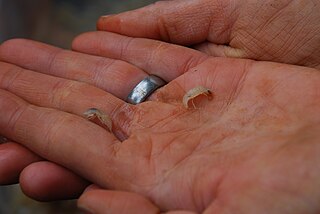
The Madison Cave isopod, Antrolana lira, is a freshwater, cave-dwelling crustacean species. It is in the family Cirolanidae and it is the only species of its genus Antrolana. This isopod can be found in flooded limestone caves and karst aquifers throughout the Great Appalachian Valley of Virginia and West Virginia. The Madison Cave isopod has been listed as a vulnerable species on the IUCN Red List since 1983 and as a threatened species under the United States Endangered Species Act since 1982. The species was named after the cave in which it was first discovered, Madison Saltpetre Cave. Very little is known about the life history and behavior of the Madison Cave isopod.
Monolistra is a genus of isopod crustaceans in the family Sphaeromatidae. Its members are restricted to countries of the former Yugoslavia, Italy and Switzerland. It contains the following subgenera and species, four of which are listed as vulnerable (VU) or endangered (EN) on the IUCN Red List:

The Cymothoidae are a family of isopods in the suborder Cymothoida found in both marine and freshwater environments. Cymoithoids are ectoparasites, usually of fish, and they include the bizarre "tongue-biter", which attaches to a fish's tongue, causing it to atrophy, and replaces the tongue with its own body. Ceratothoa oestroides is one of the most devastating ectoparasites in Mediterranean aquaculture. Around 40 genera and more than 380 species of cymothoid are recognised. Species of the Cymothoidae are generally found in warmer waters and rarely in the cool and cold climates.

A woodlouse is any crustacean belonging to the suborder Oniscidea within the order Isopoda. They get their name from often being found in old wood, and from louse, a parasitic insect, although woodlice are neither parasitic nor insects.

A giant isopod is any of the almost 20 species of large isopods in the genus Bathynomus. They are abundant in the cold, deep waters of the Atlantic, Pacific, and Indian Oceans. Bathynomus giganteus, the species upon which the generitype is based, is often considered the largest isopod in the world, though other comparably poorly known species of Bathynomus may reach a similar size. The giant isopods are noted for their resemblance to the much smaller common woodlouse, to which they are related.

Archaeoniscus is a genus of prehistoric isopods that first appeared during the Bajocian stage of the Middle Jurassic. It is a widespread genus with a paleogeographic distribution encompassing the continental margin environments of the central Atlantic Ocean and the western Tethys Ocean. Fossils of Archaeoniscus suggest that this genus lived in diverse aquatic habitats, including the marine, paralic, and freshwater environments. While earlier descriptions suggested that it may have had an ectoparasitic association with fishes, some researchers argue that at least two species, A. aranguthyorum and A. coreaensis, lived a benthic free-living lifestyle based on morphological characteristics that are either unsuitable for or unrelated to parasitic behavior.

Gelyella is a genus of freshwater copepods which are "surrounded by mystery". They live in groundwater in karstic areas of southern France and western Switzerland. The two species are the only members of the family Gelyellidae and, although previously placed in the order Harpacticoida, a new order, Gelyelloida, was erected for this family alone.
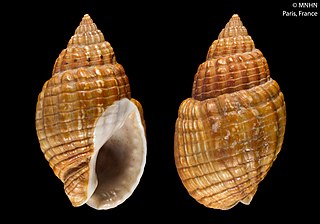
Tritia nitida is a species of sea snail, a marine gastropod mollusk in the family Nassariidae, the nassa mud snails or dog whelks.

Desis marina, the intertidal spider, is a spider species found in New Zealand, New Caledonia, and the Chatham Islands.
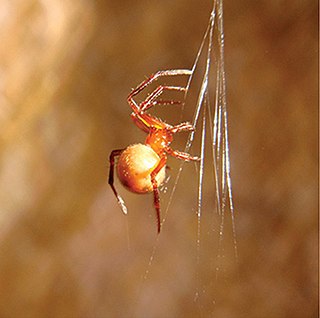
Plato is a genus of ray spider. The American biologist Jonathan A. Coddington named and circumscribed the genus in 1986. It is a Neotropical genus and it is limited to South America. As of 2018, nine species are recognized. They are found in caves and have a distinctive cubic egg sac. The generic name comes from the ancient Greek philosopher Plato.

Helleria brevicornis, the sole species of the monotypic genus Helleria, is a terrestrial woodlouse endemic to the islands and coastal regions of the northern Tyrrhenian sea. H. brevicornis is of interest due to its endemism, unique ecology and basal position in the suborder Oniscidea.

Volvation, is a defensive behavior in certain animals, in which the animal rolls its own body into a ball, presenting only the hardest parts of its integument, or its spines to predators.



















